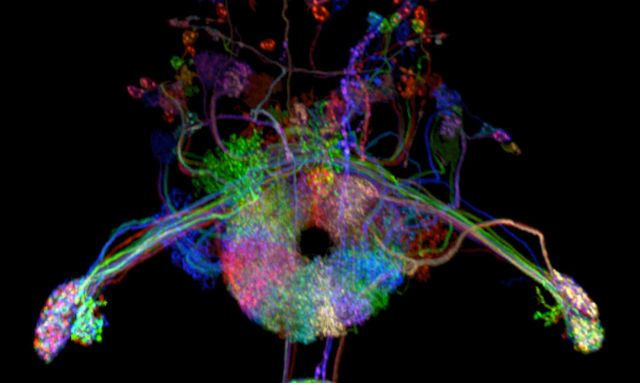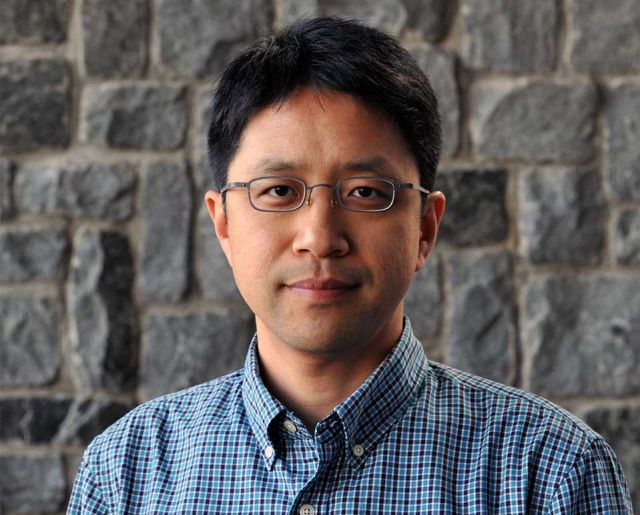How We Get Around
Neuroscientist Sung Soo Kim receives prestigious NIH award to study how brains select landmarks for navigation


By Sonia Fernandez
Whether or not we’re aware of it, humans — animals in general — constantly use environmental cues to navigate from one place to another. We choose a feature from the landscape and use it to guide our behavior, gathering and computing information about our surroundings. It’s a process so old and so essential for survival that it often occurs outside our conscious minds.
UC Santa Barbara neuroscientist Sung Soo Kim is interested in our brains’ navigation ability — the system that allows us to drive to work or home on autopilot, or get us to the bathroom and back in the middle of the night without hurting ourselves. Even when we walk into a room for the first time and the lights go out, chances are we can find our way to the exit without injuring ourselves.
“It is because your brain updates your sense of direction even in complete darkness,” Kim said. Taking the information we gather about where we are relative to the door, our brains guide us and help us avoid obstacles, while remapping our environment in our heads as we close in on our destination.
For Kim, who studies the neurons responsible for our sense of direction, the question is even more fundamental: How? How do we select the landmarks we use when we navigate? Sometimes they are attention-getting, such as signs and numbers, but often they are less obvious, like a tree on our favorite hike, the right turn on a rural road, or the silhouette of buildings in the distance that tell us we’re either going in the right direction or that we need to recalculate.
“The brain picks one stimulus out of many to guide your behavior, especially in the context of navigation,” he said. “When you navigate, there may be several landmarks. But you may use one of them as your reference, which the brain selects. And that kind of process is something that I want to understand.”
And now, with one of the biomedical field’s most prestigious awards, Kim is poised to do just that. Named one of this year’s National Institutes of Health (NIH) Director’s New Innovators, he will receive $1.5 million over five years to dive into that innate yet still mysterious aspect of the brain. Kim is one of 53 early-career investigators recognized by the NIH for their “unusually innovative research,” receiving one of 85 grants that are part of NIH’s High-Risk, High Reward Research Program.
“The breadth of innovative science put forth by the 2020 cohort of early-career and seasoned investigators is impressive and inspiring,” said NIH Director Francis S. Collins, M.D., Ph.D. “I am confident that their work will propel biomedical and behavioral research and lead to improvements in human health.”
“I congratulate Sung Soo Kim on receiving an NIH Director’s New Innovator Award,” said Pierre Wiltzius, dean of mathematical, life and physical sciences at UC Santa Barbara. “This prestigious award in a testament to the promise of Sung Soo’s early career work. I look forward to his continued contributions to the field of neuroscience, as his research has the potential to help us unlock fundamental mysteries of the human brain.”
“I’m tremendously honored to be chosen for this award,” said Kim. “This award will help me solidly establish my research group and help me perform very high-quality experiments and research.”
Using state-of-the-art techniques such as two-photon imaging, optogenetics and computational modeling, Kim and his team will observe the neuronal responses and physical behaviors of the fruit fly — a very well-understood model organism — when subjected to environmental cues that require them to navigate.
“It’s like gaming in virtual reality, the fruit fly version,” Kim explained. Immersed in an arena that simulates various scenes, the tethered insects “fly,” with researchers measuring physical responses, such as the difference between the left- and right-wingbeat amplitude that indicates a change of direction in response to the virtual reality.
“At the same time, we can record activity in the fly brain, which is smaller than the head of a pin,” Kim added. Fruit flies were found to have approximately 50 “compass neurons,” conveniently arranged along the perimeter of a donut-shaped structure in their brains called the ellipsoid body, which encode the flies’ sense of direction. “By recording the activity of these compass neurons and the neurons connected to them, you can see how the neurons as a population develop this sense of direction, and how downstream neurons can use that information to guide navigation,” Kim said.
What’s not yet fully clear is how brains select the feature or landmark around which to anchor their sense of direction.
“There are many hypotheses in the field, especially in the field of psychology, where they have conducted many experiments in stimulus selection,” Kim said. It’s an attentional process, he continued, much like how parents are able to identify their children at the playground with other children around. Kim plans to use a similar framework to unravel how the flies select their landmarks.
“The advantage of the fruit fly is that you can actually dissect, neuron by neuron, and see how they connect to, collaborate and interact with each other to perform this kind of selection process,” he said.
The outcomes of Kim’s work will not only illuminate the longstanding mysteries of how the fly brain — and by extension our own far more complex brains — choose landmarks by which to navigate, they could also serve as the foundation for future brain studies in the biomedical fields.
“If you know how the healthy brain works, when you have a brain with disease, you can compare it to the healthy brain to figure out what’s wrong,” he said.
The NIH, the nation’s medical research agency, includes 27 institutes and centers and is a component of the U.S. Department of Health and Human Services. NIH is the primary federal agency conducting and supporting basic, clinical and translational medical research and is investigating the causes, treatments and cures for both common and rare diseases.